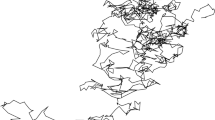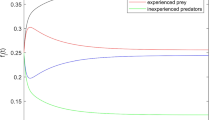Abstract
This paper investigates the stability of the power-law steady state often observed in marine ecosystems. Three dynamical systems are considered, describing the abundance of organisms as a function of body mass and time: a “jump-growth” equation, a first order approximation which is the widely used McKendrick–von Foerster equation, and a second order approximation which is the McKendrick–von Foerster equation with a diffusion term. All of these yield a power-law steady state. We derive, for the first time, the eigenvalue spectrum for the linearised evolution operator, under certain constraints on the parameters. This provides new knowledge of the stability properties of the power-law steady state. It is shown analytically that the steady state of the McKendrick–von Foerster equation without the diffusion term is always unstable. Furthermore, numerical plots show that eigenvalue spectra of the McKendrick–von Foerster equation with diffusion give a good approximation to those of the jump-growth equation. The steady state is more likely to be stable with a low preferred predator:prey mass ratio, a large diet breadth and a high feeding efficiency. The effects of demographic stochasticity are also investigated and it is concluded that these are likely to be small in real systems.
Similar content being viewed by others
References
Andersen KH, Beyer JE (2006) Asymptotic size determines species abundance in the marine size spectrum. Am Nat 168: 54–61
Anderson CNK, Hsieh C, Sandin SA, Hewitt R, Hollowed A, Beddington J, May RM, Sugihara G (2008) Why fishing magnifies fluctuations in fish abundance. Nature 452: 835–839
Arino O, Shin Y, Mullon C (2004) A mathematical derivation of size spectra in fish populations. C R Biol 327(3): 245–254
Aulbach B, Garay BM (1993) Linearizing the expanding part of noninvertible mappings. Z angew Math Phys 44(3): 469–494
Benoît E, Rochet M (2004) A continuous model of biomass size spectra governed by predation and the effects of fishing on them. J Theor Biol 226(1): 9–21
Blanchard JL, Jennings S, Law R, Castle MD, McCloghrie P, Rochet M, Benoît E (2009) How does abundance scale with body size in coupled size-structured food webs?. J Anim Ecol 78(1): 270–280
Boudreau P, Dickie L (1992) Biomass spectra of aquatic ecosystems in relation to fisheries yield. Can J Fish Aquat Sci 49(8): 1528–1538
Camacho J, Solé RV (2001) Scaling in ecological size spectra. Europhys Lett 55(6): 774–780
Capitan JA, Delius GW (2010) Scale-invariant model of marine population dynamics. Phys Rev E 81(6): 061901
Cohen JE, Jonsson T, Carpenter SR (2003) Ecological community description using the food web, species abundance, and body size. Proc Natl Acad Sci USA 100(4): 1781–1786
Datta S, Delius GW, Law R (2010) A Jump-Growth model for PredatorPrey dynamics: derivation and application to marine ecosystems. Bull Math Biol 72(6):1361–1382. http://arxiv.org/abs/0812.4968
Hsieh C, Reiss CS, Hunter JR, Beddington JR, May RM, Sugihara G (2006) Fishing elevates variability in the abundance of exploited species. Nature 443: 859–862
Kirchgraber U, Palmer KJ (1990) Geometry in the neighborhood of invariant manifolds of maps and flows and linearization. Longman Scientific & Technical, Harlow
Law R, Plank MJ, James A, Blanchard JL (2009) Size-spectra dynamics from stochastic predation and growth of individuals. Ecology 90(3): 802–811
McKane AJ, Newman TJ (2005) Predator–prey cycles from resonant amplification of demographic stochasticity. Phys Rev Lett 94: 218102
Murray JD (2002) Mathematical biology, I: an introduction, 3rd edn. Springer, Berlin
Platt T, Denman K (1978) The structure of pelagic marine ecosystems. Rapports et Procés-Verbaux Des Réunions, Conseil International Pour l’Exploration de la Mer 173: 60–65
Rooney N, McCann K, Gellner G, Moore JC (2006) Structural asymmetry and the stability of diverse food webs. Nature 442: 265–269
Samoilov M, Plyasunov S, Arkin AP (2005) Stochastic amplification and signaling in enzymatic futile cycles through noise-induced bistability with oscillations. Proc Natl Acad Sci USA 102(7): 2310–2315
Sheldon R, Parsons T (1967) A continuous size spectrum for particulate matter in the sea. J Fish Res Board Canada 24(5): 909–915
Sheldon RW, Prakash A, Sutcliffe WH Jr (1972) The size distribution of particles in the ocean. Limnol Oceanogr 17(3): 327–340
Silvert W (1980) Dynamic energy-flow model of the particle size distribution in pelagic ecosystems. In: Kerfoot W (eds) Evolution and ecology of zooplankton communities. University Press of New England, Hanover, pp 754–763
Silvert W, Platt T (1978) Energy flux in the pelagic ecosystem: a time-dependent equation. Limnol Oceanogr 23(4): 813–816
van Kampen NG (1992) Stochastic processes in physics and chemistry. Elsevier, Amsterdam
Ware DM (1978) Bioenergetics of pelagic fish: theoretical change in swimming speed and ration with body size. J Fisher Res Board Canada 35: 220–228
Author information
Authors and Affiliations
Corresponding author
Rights and permissions
About this article
Cite this article
Datta, S., Delius, G.W., Law, R. et al. A stability analysis of the power-law steady state of marine size spectra. J. Math. Biol. 63, 779–799 (2011). https://doi.org/10.1007/s00285-010-0387-z
Received:
Revised:
Published:
Issue Date:
DOI: https://doi.org/10.1007/s00285-010-0387-z




